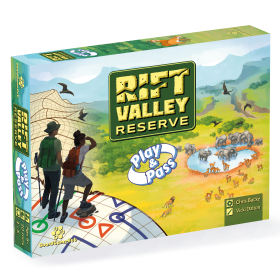riftvalleyreserve
 Rift Valley Reserve is a highly interactive drawing game set in the Great Rift Valley, Uganda.
Rift Valley Reserve is a highly interactive drawing game set in the Great Rift Valley, Uganda.
Players compete to draw the most attractive scenic walking trails.
Rift Valley Reserve is highly tactical with no luck. Players pass shared boards around the table, allowing for strategic blocking opportunities.
Antall spillere: 2 - 5
Lengde: 16 mn
Kompleksitet: 2 / 5
Spill riftvalleyreserve og 963 andre spill online.
Ingen nedlasting nødvendig - spill direkte fra nettleseren din.
Med vennene dine og tusenvis av spillere fra hele verden.
Gratis.

Spill riftvalleyreserve og 963 andre spill online.
Ingen nedlasting nødvendig - spill direkte fra nettleseren din.
Med vennene dine og tusenvis av spillere fra hele verden.
Gratis.

Regelsammendrag
Summary
Rift Valley Reserve is a game about strategically arranging scenic hiking trails on shared boards. Each turn, players draw a single element on the board in front of them. Then, they pass the board to their left.
Gameplay
All players take turns simultaneously and draw in their own color.
On the first turn, players must draw a Stop (a circle) on any empty space that is NOT adjacent to an animal vertically, horizontally, or diagonally.
On later turns, players must choose to:
- Draw another Stop. Stops adjacent to animals are allowed on later turns. However, Stops must NOT be vertically or horizontally adjacent to other Stops. Diagonal adjacency is allowed.
- Or, draw a Trail (a line).
- Or, draw a Tent (a triangle).
Stops
Stops must NOT be vertically or horizontally adjacent to other Stops. Diagonal adjacency is allowed.
At game end, each Stop that is NOT connected to a trail penalizes its owner -2 points.
Trails
Trails can be drawn between two Stops owned by the same player. The Trail must be drawn by this player.
Trails cannot cross any element (animal, tree, water, Stop, Trail, Tent, Rift) except the player's own Rift as described later.
Trails can be a straight line, or an L with a single 90-degree corner.
At game end, each Trail scores its owner 1 point per area it enters. Areas are the board regions surrounded by thick borders. Every board has 9 areas, and a Trail scores from a minimum of 1 to a maximum of 5 points.
At game end, each animal square scores players a variable number of points as described in the Scoring section below. Each animal square only scores for a player if that player has at least one Trail adjacent to it. The connected Stops are considered part of a Trail. The Trail can be vertically, horizontally, or diagonally adjacent to the animal square.
Tents
At game end, each Tent scores its owner 2 points for each adjacent connected Stop the same player owns. A connected Stop is a Stop with a Trail drawn to it. These connected Stops can be vertically, horizontally, or diagonally adjacent to the Tent.
Each map can have at most 5 Tents.
Rifts
Each board has a Rift, which is a canyon that blocks Trails. However, the Rift has a colored border around it indicating which player started the game with that board. The player with this color is allowed to bridge their own Rift with Trails. These bridges must only be drawn the short way, perpendicular to the Rift.
End of Turn
When all players have drawn an element, each player passes the board in front of them to their left.
End of Game
The end of the game is triggered when a certain number of boards have reached their capacity of 5 Tents:
- 2 players: 2 boards
- 3 players: 2 boards
- 4 players: 3 boards
- 5 players: 4 boards
At this point, players continue taking turns until each player has taken a final turn on the board they started with. This is the board with the Rift of their color.
In this final game stage after the end of the game was triggered, players are allowed to pass instead of drawing an element, if they wish.
Identical and Asymmetrical Boards
The Identical Boards option gives all players a smaller, identical board.
The Asymmetrical Boards option gives all players one of 5 random boards. These boards are larger. They also include water and tree obstacles.
Scoring
At game end, all boards are scored for all players. Each player sums their individual scores from each board to calculate their total score.
Players score:
- 1 point per area each of their trails enters. At minimum, a trail scores 1 point.
- 1 point per kob (a type of antelope) square with at least 1 of their trails adjacent vertically, horizontally, or diagonally.
- 2 points per elephant square with at least 1 of their trails adjacent vertically, horizontally, or diagonally.
- 3 points per lion square with at least 1 of their trails adjacent vertically, horizontally, or diagonally.
- -2 points per unconnected stop of their color.
- For each tent of their color, 2 points per connected stop of their color adjacent vertically, horizontally, or diagonally.
If there is a tie, the tied player with the single highest-scoring board wins. If there is still a tie, check the next highest-scoring board, etc.


